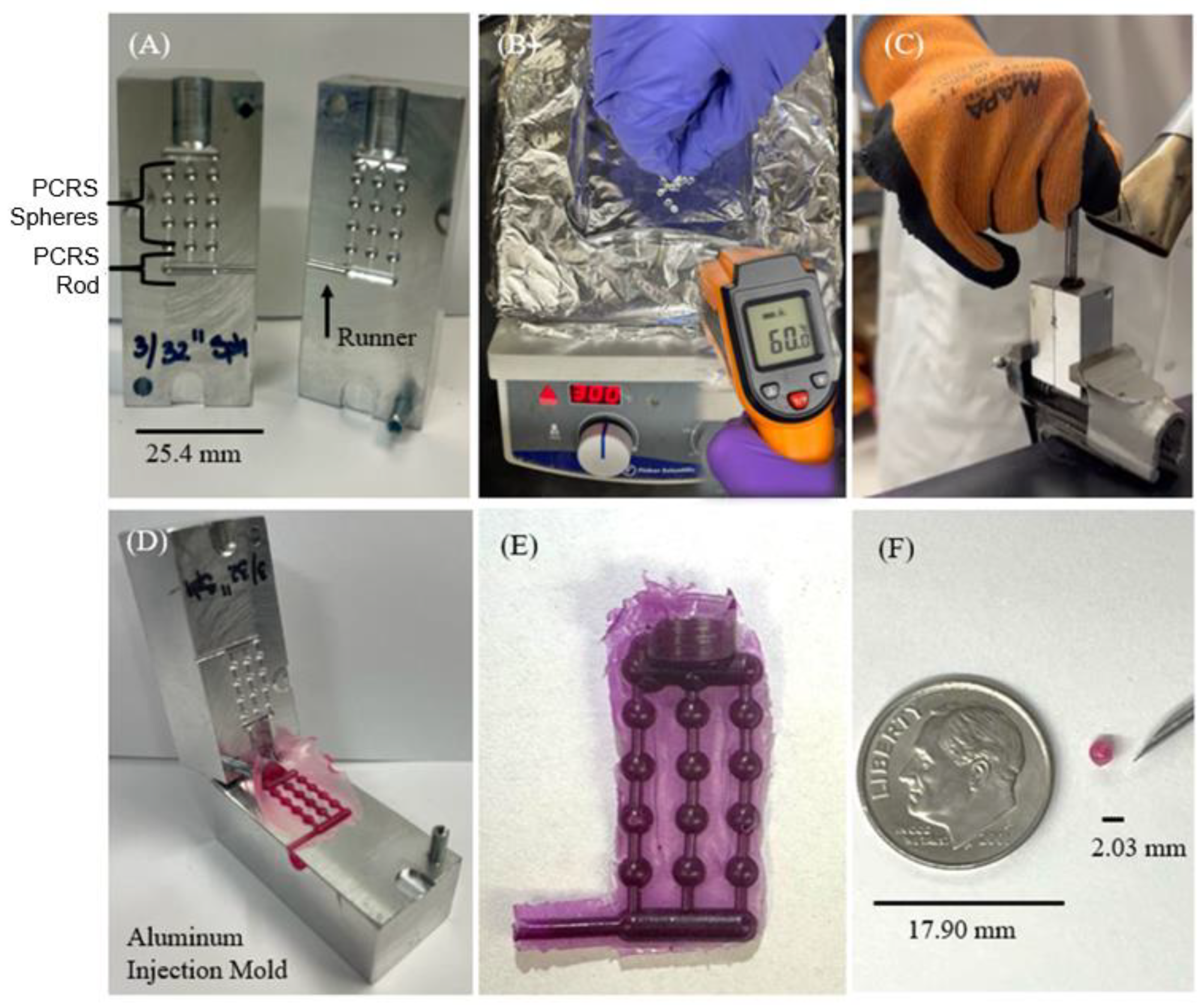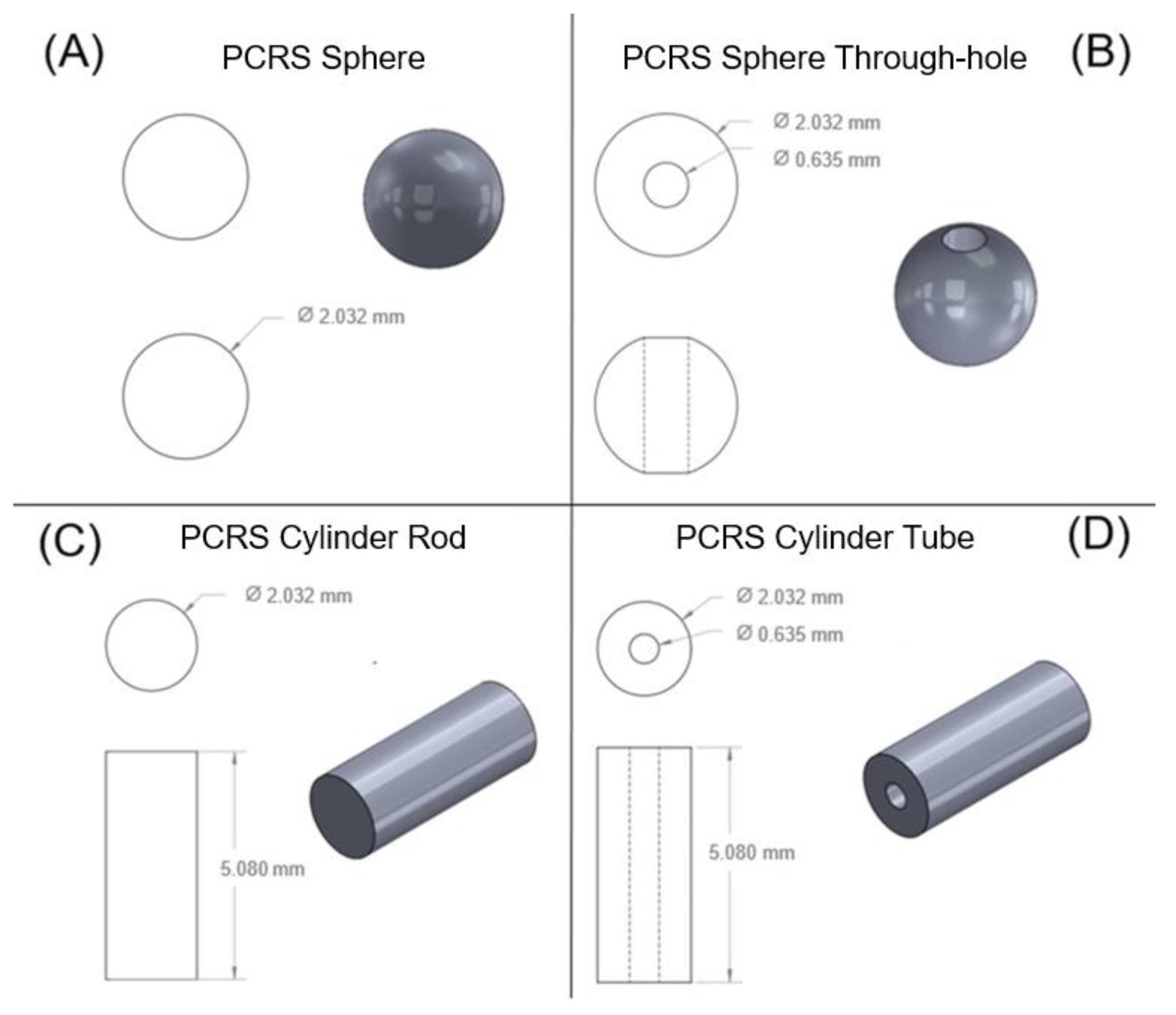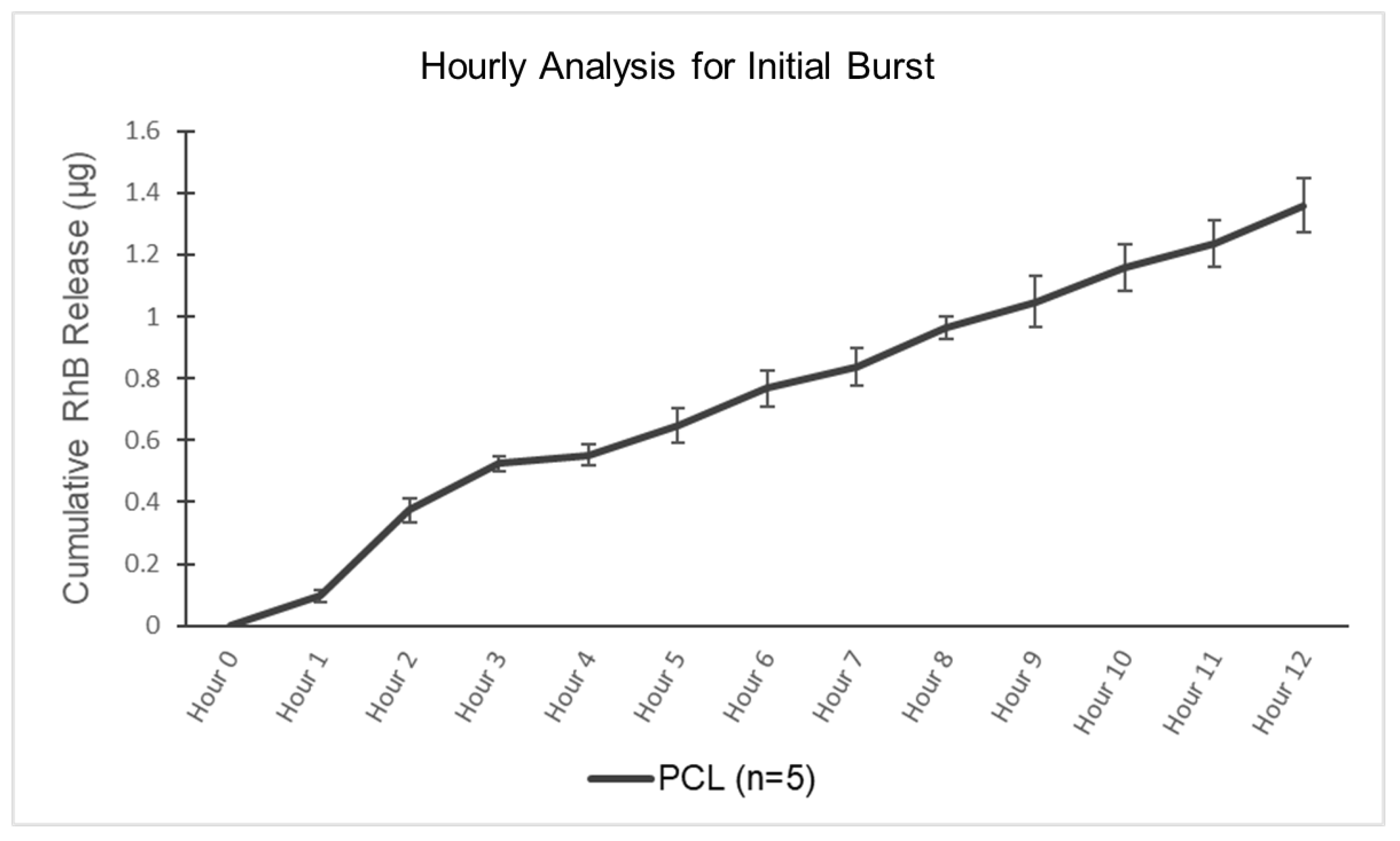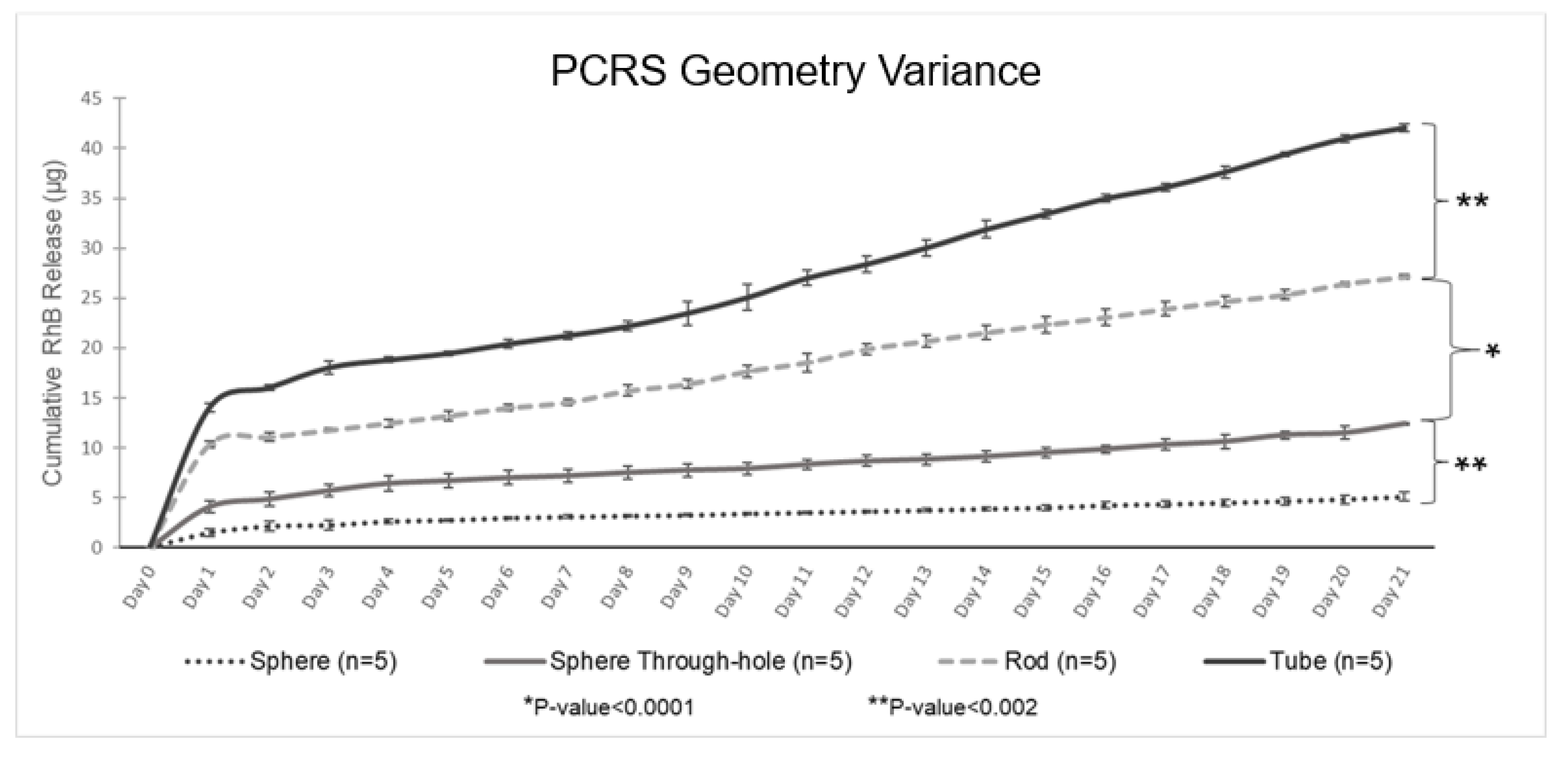An Innovative Polymeric Platform for Controlled and Localized Drug Delivery
Abstract
1. Introduction
2. Materials and Methods
2.1. Biomaterials
2.2. Polymer Casting Molding
2.3. Controlled Release Experimental Protocol
2.4. Mixture Homogeneity Tests
2.5. Initial Release Experiments
2.6. Single Spherical Device Experiments
2.7. Geometry Variance Experiments
3. Results and Discussion
3.1. Casting Polymer Reproducibility Analysis
3.2. Mixture Homogeneity Release Analysis
3.3. Initial Release Analysis
3.4. Single Spherical Device Analysis
3.5. Geometry Variance Analysis
3.6. Study Limitations
4. Conclusions
5. Patents
Author Contributions
Funding
Institutional Review Board Statement
Informed Consent Statement
Data Availability Statement
Acknowledgments
Conflicts of Interest
References
- Federico, C.; Sun, J.; Muz, B.; Alhallak, K.; Cosper, P.F.; Muhammad, N.; Jeske, A.; Hinger, A.; Markovina, S.; Grigsby, P.; et al. Localized Delivery of Cisplatin to Cervical Cancer Improves Its Therapeutic Efficacy and Minimizes Its Side Effect Profile. Int. J. Radiat. Oncol. 2021, 109, 1483–1494. [Google Scholar] [CrossRef]
- Poniewierza, P.; Panek, G. Cervical Cancer Prophylaxis—State-of-the-Art and Perspectives. Healthcare 2022, 10, 1325. [Google Scholar] [CrossRef]
- Society, A.C. Key Statistics for Cervical Cancer. 2023. Available online: https://www.cancer.org/cancer/cervical-cancer/about/key-statistics.html (accessed on 13 January 2023).
- Adiga, D.; Eswaran, S.; Pandey, D.; Sharan, K.; Kabekkodu, S.P. Molecular landscape of recurrent cervical cancer. Crit. Rev. Oncol. 2021, 157, 103178. [Google Scholar] [CrossRef] [PubMed]
- Mamidi, N.; González-Ortiz, A.; Romo, I.L.; Barrera, E.V. Development of functionalized carbon nano-onions reinforced zein protein hydrogel interfaces for controlled drug release. Pharmaceutics 2019, 11, 621. [Google Scholar] [CrossRef] [PubMed]
- Hood, R.L.; Bruno, G.; Jain, P.; Anderson, J.; Wolfe, T.; Quini, C.C.; Schmulen, J.; Li, X.C.; Butler, E.B.; Krishnan, S.; et al. Nanochannel implants for minimally-invasive insertion and intratumoral delivery. J. Biomed. Nanotechnol. 2016, 12, 1907–1915. [Google Scholar] [CrossRef]
- Hood, R.L.; Hood, G.D.; Ferrari, M.; Grattoni, A. Pioneering medical advances through nanofluidic implantable technologies. WIREs Nanomed. Nanobiotechnol. 2017, 9, e1455. [Google Scholar] [CrossRef]
- Bruno, G.; Di Trani, N.; Hood, R.L.; Zabre, E.; Filgueira, C.S.; Canavese, G.; Jain, P.; Smith, Z.; Demarchi, D.; Hosali, S.; et al. Unexpected behaviors in molecular transport through size-controlled nanochannels down to the ultra-nanoscale. Nat. Commun. 2018, 9, 1682. [Google Scholar] [CrossRef]
- Geninatti, T.; Bruno, G.; Barile, B.; Hood, R.L.; Farina, M.; Schmulen, J.; Canavese, G.; Grattoni, A. Impedance characterization, degradation, and in vitro biocompatibility for platinum electrodes on BioMEMS. Biomed. Microdevices 2015, 17, 24. [Google Scholar] [CrossRef] [PubMed]
- Brown, A.; Kumar, S.; Tchounwou, P.B. Cisplatin-Based Chemotherapy of Human Cancers. J. Cancer Sci. Ther. 2019, 11, 97. [Google Scholar]
- Dantas, M.V.M.; Verzola, M.H.A.; Sanitá, P.V.; Dovigo, L.N.; Cerri, P.S.; Gabrielli, M.A.C. The influence of Cisplatin-based chemotherapy on the osseointegration of dental implants: An in vivo mechanical and histometrical study. Clin. Oral Implant. Res. 2019, 30, 603–616. [Google Scholar] [CrossRef]
- Zhu, J.; Zhang, Z.; Bian, D.; Chen, Q.; Hu, Q.; Ji, S.; Gu, K. Weekly versus triweekly cisplatin-based concurrent chemoradiotherapy in the treatment of locally advanced cervical carcinoma: An updated meta-analysis based on randomized controlled trials. Meidicine 2020, 99, e18663. [Google Scholar] [CrossRef] [PubMed]
- Herrera-Ruiz, A.; Tovar, B.B.; García, R.G.; Tamez, M.F.L.; Mamidi, N. Nanomaterials-Incorporated Chemically Modified Gelatin Methacryloyl-Based Biomedical Composites: A Novel Approach for Bone Tissue Engineering. Pharmaceutics 2022, 14, 2645. [Google Scholar] [CrossRef] [PubMed]
- Siddik, Z.H. Cisplatin: Mode of cytotoxic action and molecular basis of resistance. Oncogene 2003, 22, 7265–7279. [Google Scholar] [CrossRef]
- Tsang, R.Y.; Al-Fayea, T.; Au, H.-J. Cisplatin Overdose. Drug Saf. 2009, 32, 1109–1122. [Google Scholar] [CrossRef]
- Mamidi, N.; Zuníga, A.E.; Villela-Castrejón, J. Engineering and evaluation of forcespun functionalized carbon nano-onions reinforced poly (ε-caprolactone) composite nanofibers for pH-responsive drug release. Mater. Sci. Eng. C 2020, 112, 110928. [Google Scholar] [CrossRef] [PubMed]
- Hood, R.L.; Andriani, R.T.; Ecker, T.E.; Robertson, J.L.; Rylander, C.G. Characterizing Thermal Augmentation of Convection-Enhanced Drug Delivery with the Fiberoptic Microneedle Device. Engineering 2015, 1, 344–350. [Google Scholar] [CrossRef]
- Mamidi, N.; Delgadillo, R.M.V. Design, fabrication and drug release potential of dual stimuli-responsive composite hydrogel nanoparticle interfaces. Colloids Surf. B Biointerfaces 2021, 204, 111819. [Google Scholar] [CrossRef]
- Moreno-Núñez, B.A.; Abarca-Vidal, C.G.; Treviño-Quintanilla, C.D.; Sánchez-Santana, U.; Cuan-Urquizo, E.; Uribe-Lam, E. Experimental Analysis of Fiber Reinforcement Rings’ Effect on Tensile and Flexural Properties of Onyx™–Kevlar® Composites Manufactured by Continuous Fiber Reinforcementt. Polymers 2023, 15, 1252. [Google Scholar] [CrossRef] [PubMed]
- Han, Y.; Wen, P.; Li, J.; Kataoka, K. Targeted nanomedicine in cisplatin-based cancer therapeutics. J. Control. Release 2022, 345, 709–720. [Google Scholar] [CrossRef]
- Rajkumar, P. Cisplatin Concentrations in Long and Short Duration Infusion: Implications for the Optimal Time of Radiation Delivery. J. Clin. Diagn. Res. 2016, 10, Xc01–Xc04. [Google Scholar] [CrossRef]
- Ashok, B.; Peppas, N.A.; Wechsler, M.E. Lipid- and polymer-based nanoparticle systems for the delivery of CRISPR/Cas9. J. Drug Deliv. Sci. Technol. 2021, 65, 102728. [Google Scholar] [CrossRef] [PubMed]
- Mitchell, M.J.; Billingsley, M.M.; Haley, R.M.; Wechsler, M.E.; Peppas, N.A.; Langer, R. Engineering precision nanoparticles for drug delivery. Nat. Rev. Drug Discov. 2021, 20, 101–124. [Google Scholar] [CrossRef] [PubMed]
- Braatz, D.; Dimde, M.; Ma, G.; Zhong, Y.; Tully, M.; Grötzinger, C.; Zhang, Y.; Mavroskoufis, A.; Schirner, M.; Zhong, Z.; et al. Toolbox of Biodegradable Dendritic (Poly glycerol sulfate)–SS-poly(ester) Micelles for Cancer Treatment: Stability, Drug Release, and Tumor Targeting. Biomacromolecules 2021, 22, 2625–2640. [Google Scholar] [CrossRef] [PubMed]
- Azab, A.K.; Doviner, V.; Orkin, B.; Kleinstern, J.; Srebnik, M.; Nissan, A.; Rubinstein, A. Biocompatibility evaluation of crosslinked chitosan hydrogels after subcutaneous and intraperitoneal implantation in the rat. J. Biomed. Mater. Res. Part A 2007, 83, 414–422. [Google Scholar] [CrossRef] [PubMed]
- De la Puente, P.; Fettig, N.; Luderer, M.J.; Jin, A.; Shah, S.; Muz, B.; Kapoor, V.; Goddu, S.M.; Salama, N.N.; Tsien, C.; et al. Injectable hydrogels for localized chemotherapy and radiotherapy in brain tumors. J. Pharm. Sci. 2018, 107, 922–933. [Google Scholar] [CrossRef] [PubMed]
- Jain, S.; Venkataraman, A.; Wechsler, M.E.; Peppas, N.A. Messenger RNA-based vaccines: Past, present, and future directions in the context of the COVID-19 pandemic. Adv. Drug Deliv. Rev. 2021, 179, 114000. [Google Scholar] [CrossRef]
- Akhter, F.; Bascos, G.N.W.; Canelas, M.; Griffin, B.; Hood, R.L. Mechanical characterization of a fiberoptic microneedle device for controlled delivery of fluids and photothermal excitation. J. Mech. Behav. Biomed. Mater. 2020, 112, 104042. [Google Scholar] [CrossRef]
- Akhter, F.; Manrique-Bedoya, S.; Moreau, C.; Smith, A.L.; Feng, Y.; Mayer, K.M.; Hood, R.L. Assessment and Modeling of Plasmonic Photothermal Therapy Delivered via a Fiberoptic Microneedle Device Ex Vivo. Pharmaceutics 2021, 13, 2133. [Google Scholar] [CrossRef]
- Zhang, Q.; Bao, J.; Duan, T.; Hu, M.; He, Y.; Wang, J.; Hu, R.; Tang, J. Nanomicelle-Microsphere Composite as a Drug Carrier to Improve Lung-Targeting Specificity for Lung Cancer. Pharmaceutics 2022, 14, 510. [Google Scholar] [CrossRef]
- Uribe-Lam, E.; Treviño-Quintanilla, C.D.; Cuan-Urquizo, E.; Olvera-Silva, O. Use of additive manufacturing for the fabrication of cellular and lattice materials: A review. Mater. Manuf. Process. 2021, 36, 257–280. [Google Scholar] [CrossRef]
- Ballerini, A.; Filgueira, C.S.; Nicolov, E.; Jain, P.; Bruno, G.; Hood, R.L.; Scaglione, F.; Grattoni, A. Sustained Delivery of Tamoxifen from a Nanofluidic Delivery Platform. Drug Deliv. Lett. 2016, 6, 127–133. [Google Scholar] [CrossRef]
- Filipović, N.; Veselinović, L.; Ražić, S.; Jeremić, S.; Filipič, M.; Žegura, B.; Tomić, S.; Čolić, M.; Stevanović, M. Poly (ε-caprolactone) microspheres for prolonged release of selenium nanoparticles. Mater. Sci. Eng. C 2019, 96, 776–789. [Google Scholar] [CrossRef] [PubMed]
- Portillo, D.J.; Hoffman, E.N.; Garcia, M.; LaLonde, E.; Hernandez, E.; Combs, C.S.; Hood, L. Modal analysis of a sweeping jet emitted by a fluidic oscillator. In Proceedings of the AIAA AVIATION 2021 FORUM, Virtual Event, 2–6 August 2021. [Google Scholar]
- Chen, Y.-P.; Liu, Y.-W.; Lee, D.; Qiu, J.T.; Lee, T.-Y.; Liu, S.-J. Biodegradable andrographolide-eluting nanofibrous membranes for the treatment of cervical cancer. Int. J. Nanomed. 2019, 14, 421–429. [Google Scholar] [CrossRef] [PubMed]
- Ryalat, S.; Darwish, R.; Amin, W. New form of administering chlorhexidine for treatment of denture-induced stomatitis. Ther. Clin. Risk Manag. 2011, 7, 219–225. [Google Scholar] [CrossRef]
- Wechsler, M.E.; Stephenson, R.E.; Murphy, A.C.; Oldenkamp, H.F.; Singh, A.; Peppas, N.A. Engineered microscale hydrogels for drug delivery, cell therapy, and sequencing. Biomed. Microdevices 2019, 21, 31. [Google Scholar] [CrossRef]
- Wechsler, M.E.; Clegg, J.R.; Peppas, N.A. The interface of drug delivery and regenerative medicine. In Encyclopedia of Tissue Engineering and Regenerative Medicine; Reis, R.L., Gomes, M.E., Eds.; Academic Press: Cambridge, MA, USA, 2019; Volume 1, pp. 77–86. [Google Scholar]
- Berard, D.; Navarro, J.D.; Bascos, G.; Harb, A.; Feng, Y.; De Lorenzo, R.; Hood, R.L.; Restrepo, D. Novel expandable architected breathing tube for improving airway securement in emergency care. J. Mech. Behav. Biomed. Mater. 2021, 114, 104211. [Google Scholar] [CrossRef]
- Copeland, G.B.; Zilevicius, D.J.; Bedolla, C.N.; Islas, A.L.; Guerra, M.N.; Salazar, S.J.; A De Lorenzo, R.; Schauer, S.G.; Hood, R.L. Review of Commercially Available Supraglottic Airway Devices for Prehospital Combat Casualty Care. Mil. Med. 2022, 187, e862–e876. [Google Scholar] [CrossRef] [PubMed]
- Fu, Y.; Kao, W.J. Drug release kinetics and transport mechanisms of non-degradable and degradable polymeric delivery systems. Expert Opin. Drug Deliv. 2010, 7, 429–444. [Google Scholar] [CrossRef]
- Kim, J.; Kudisch, M.; Mudumba, S.; Asada, H.; Aya-Shibuya, E.; Bhisitkul, R.B.; Desai, T.A. Biocompatibility and pharmacokinetic analysis of an intracameral polycaprolactone drug delivery implant for glaucoma. Investig. Ophthalmol. Vis. Sci. 2016, 57, 4341–4346. [Google Scholar] [CrossRef]
- Elmowafy, E.M.; Tiboni, M.; Soliman, M.E. Biocompatibility, biodegradation and biomedical applications of poly (lactic acid)/poly (lactic-co-glycolic acid) micro and nanoparticles. J. Pharm. Investig. 2019, 49, 347–380. [Google Scholar] [CrossRef]
- Senapati, S.; Mahanta, A.K.; Kumar, S.; Maiti, P. Controlled drug delivery vehicles for cancer treatment and their performance. Signal Transduct. Target. Ther. 2018, 3, 7. [Google Scholar] [CrossRef] [PubMed]
- Vaid, R.; Yildirim, E.; Pasquinelli, M.A.; King, M.W. Hydrolytic degradation of polylactic acid fibers as a function of ph and exposure time. Molecules 2021, 26, 7554. [Google Scholar] [CrossRef] [PubMed]
- Wang, Z.; Liu, H.; Shu, X.; Zheng, L.; Chen, L. A reduction-degradable polymer prodrug for cisplatin delivery: Preparation, in vitro and in vivo evaluation. Colloids Surf. B Biointerfaces 2015, 136, 160–167. [Google Scholar] [CrossRef] [PubMed]
- Noh, J.J.; Kim, M.-S.; Cho, Y.-J.; Jeong, S.-Y.; Lee, Y.-Y.; Ryu, J.-Y.; Choi, J.-J.; Bae, I.; Wu, Z.; Kim, B.-G.; et al. Anti-Cancer Activity of As4O6 and its Efficacy in a Series of Patient-Derived Xenografts for Human Cervical Cancer. Pharmaceutics 2020, 12, 987. [Google Scholar] [CrossRef]








| Devices | Surface Area (mm2) | Dimensions (mm) | Center through- Hole (mm) | Average Mass Weight (µg) | Mass Weight Tolerance (µg) | 99% Polymer (µg) | 1% RhB (µg) | % Release at 21 Days |
|---|---|---|---|---|---|---|---|---|
| PCRS Sphere | 12.968 | ⌀ 2.032 | N/A | 6000 | ±100 | 5940 | 60 | 18.07% |
| PCRS Sphere Through-hole | 16.387 | ⌀ 2.032 | ⌀ 0.635 | 5600 | ±100 | 5544 | 56 | 22.13% |
| PCRS Cylinder Rod | 38.903 | 5.080 × 2.032 | N/A | 15,100 | ±100 | 14,949 | 151 | 13.56% |
| PCRS Cylinder tube | 48.3870 | 5.080 × 2.032 | ⌀ 0.635 | 20,000 | ±100 | 19,800 | 200 | 27.86% |
| Phase | Days | Number of Samples | Initial Mass Release (μg) | Final Mass Release (μg) | R2 Value |
|---|---|---|---|---|---|
| I | 0–1 | 4 | 0.000 | 0.596 | N/A |
| II | 2–12 | 4 | 0.596 | 1.523 | 0.932 |
Disclaimer/Publisher’s Note: The statements, opinions and data contained in all publications are solely those of the individual author(s) and contributor(s) and not of MDPI and/or the editor(s). MDPI and/or the editor(s) disclaim responsibility for any injury to people or property resulting from any ideas, methods, instructions or products referred to in the content. |
© 2023 by the authors. Licensee MDPI, Basel, Switzerland. This article is an open access article distributed under the terms and conditions of the Creative Commons Attribution (CC BY) license (https://creativecommons.org/licenses/by/4.0/).
Share and Cite
Elbjorn, M.; Provencio, J.; Phillips, P.; Sainz, J.; Harrison, N.; Rocco, D.D.; Jaramillo, A.; Jain, P.; Lozano, A.; Hood, R.L. An Innovative Polymeric Platform for Controlled and Localized Drug Delivery. Pharmaceutics 2023, 15, 1795. https://doi.org/10.3390/pharmaceutics15071795
Elbjorn M, Provencio J, Phillips P, Sainz J, Harrison N, Rocco DD, Jaramillo A, Jain P, Lozano A, Hood RL. An Innovative Polymeric Platform for Controlled and Localized Drug Delivery. Pharmaceutics. 2023; 15(7):1795. https://doi.org/10.3390/pharmaceutics15071795
Chicago/Turabian StyleElbjorn, Monica, Jacob Provencio, Paige Phillips, Javier Sainz, Noah Harrison, David Di Rocco, Ada Jaramillo, Priya Jain, Alejandro Lozano, and R. Lyle Hood. 2023. "An Innovative Polymeric Platform for Controlled and Localized Drug Delivery" Pharmaceutics 15, no. 7: 1795. https://doi.org/10.3390/pharmaceutics15071795
APA StyleElbjorn, M., Provencio, J., Phillips, P., Sainz, J., Harrison, N., Rocco, D. D., Jaramillo, A., Jain, P., Lozano, A., & Hood, R. L. (2023). An Innovative Polymeric Platform for Controlled and Localized Drug Delivery. Pharmaceutics, 15(7), 1795. https://doi.org/10.3390/pharmaceutics15071795







